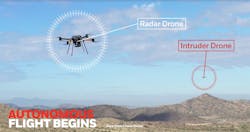PHOENIX - A drone piloted by the Honeywell IntuVue RDR-84K radar system has triumphed in a high-stakes game of dodgeball, repeatedly swerving around intruder aircraft in a series of tests that are key to the future of pilotless aviation.
The tests, which took place near Phoenix, showed that the radar can not only detect airborne traffic but can also decide autonomously on a course of action. The radar can take over navigation and pilot an aircraft to safety using its onboard processor.
Avoiding unforeseen objects is a key requirement for autonomous drones and other aircraft that fly beyond visual line of sight (BVLOS) of an operator. Radars must have long ranges because of the high speeds involved, and they must pick out airborne traffic from ground clutter, including moving cars. They also require precise location information to make sense of radar echoes.
This is difficult on the ground and even more complex in the sky. To compensate, pilots, and even huge air traffic control radars, rely on cooperative aircraft to beam out their locations using onboard transponders. Objects without transponders — hobby drones, kites, birds and aircraft with broken transponders - are known as “noncooperating” traffic.
The RDR-84K, which is the size of a paperback book, has proven its ability to detect noncooperating traffic during extensive testing while mounted on helicopters and drones. But the new tests marked the first time it has performed the avoidance function without human intervention.
With both drones on autopilot, Honeywell engineers flew two quadcopter drones directly at each other 300 feet above the ground at a test site in the desert.
To watch the demonstration, click here.

